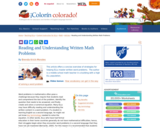
This article offers a concise overview of strategies for helping ELLs master written word problems. The author is a middle school math teacher in a building with a high ELL population.

This article offers a concise overview of strategies for helping ELLs master written word problems. The author is a middle school math teacher in a building with a high ELL population.
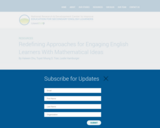
Redefining Approaches for Engaging English Learners With Mathematical Ideas
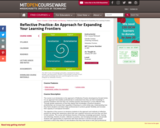
Small group study of advanced subjects under staff supervision. For graduate students wishing to pursue further study in advanced areas of urban studies and city and regional planning not covered in regular subjects of instruction. The course is an introduction to the approach of Reflective Practice developed by Donald SchĚŚn. It is an approach that enables professionals to understand how they use their knowledge in practical situations and how they can combine practice and learning in a more effective way. Through greater awareness of how they deploy their knowledge in practical situations, professionals can increase their capacities of learning in a more timely way. Understanding how they frame situations and ideas helps professionals to achieve greater flexibility and increase their capacity of conceptual innovation. The objective of the course is to introduce students to the approach and methods of reflective practice by raising their awareness about their own cognitive resources and how they use them in their practice. The course will introduce theories of learning, knowledge generation, framing and reframing, theories of action, reflection-in-practice, and conceptual innovation, and provide students with opportunities to experiment with these theories in real life through practical exercises in which they reflect on real situations that they have faced in their past professional experience. Through these practical exercises, students will have the opportunity to reflect on their thinking capacities in the context of their practice.
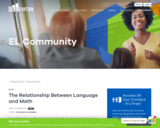
Any math teacher can attest that language and math are intertwined in every lesson: from the verbal instruction to teach a concept to comprehending a word problem to verbalizing how the student got their answer. For these reasons, math class can be a major point of frustration for students learning English. Equally frustrated are the educators who recognize the difficulty these language barriers present, but struggle to find strategies to reconcile it. » Read more at https://ellevationeducation.com/language-math-unpacking-relationship
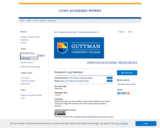
Related lesson plans are also available for download and adaptation in the Guttman Community College OER collection in the CUNY Academic Works institutional repository.

Students can come across all kinds of negative content online and on social media, whether it's rude, mean, or even hateful. But what should students do when they encounter hate speech online? Have students think through digital dilemmas and identify the best ways to respond.
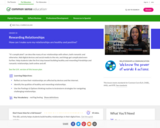
It's complicated can describe many of our relationships with others, both romantic and otherwise. Add digital devices and social media to the mix, and things get complicated even further. Help students take the first step toward building healthy and rewarding friendships and romantic relationships, both online and off.
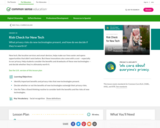
New tech, like location services and smart devices, helps make our lives easier and opens opportunities that didn't exist before. But these innovations also come with a cost -- especially to our privacy. Help students consider the benefits and drawbacks of these new technologies -- and decide whether they're ultimately worth it.
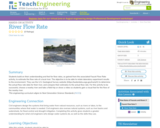
Students build on their understanding and feel for flow rates, as gained from the associated Faucet Flow Rate activity, to estimate the flow rate of a local river. The objective is to be able to relate laboratory experiment results to the environment. They use the U.S. Geological Survey website (http://waterdata.usgs.gov/nwis/rt) to determine the actual flow rate data for their river, and compare their estimates to the actual flow rate. For this activity to be successful, choose a nearby river and take a field trip or show a video so students gain a visual feel for the flow of the nearby river.
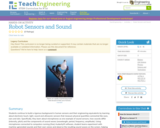
Students continue to build a rigorous background in human sensors and their engineering equivalents by learning about electronic touch, light, sound and ultrasonic sensors that measure physical quantities somewhat like eyes, ears and skin. Specifically, they learn about microphones as one example of sound sensors, how sounds differ (intensity, pitch) and the components of sound waves (wavelength, period, frequency, amplitude). Using microphones connected to computers running (free) Audacity® software, student teams experiment with machine-generated sounds and their own voices and observe the resulting sound waves on the screen, helping them to understand that sounds are waves. Students take pre/post quizzes, complete a worksheet and watch two short online videos about "seeing" sound.
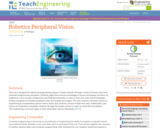
This unit is designed for advanced programming classes. It leads students through a study of human vision and computer programming simulation. Students apply their previous knowledge of arrays and looping structures to implement a new concept of linked lists and RGB decomposition in order to solve the unit's Grand Challenge: writing a program to simulate peripheral vision by merging two images. This unit connects computer science to engineering by incorporating several science topics (eye anatomy, physics of light and color, mathematics, and science of computers) and guides students through the design process in order to create final simulations.
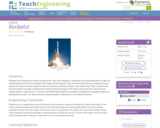
Students are introduced to statics and dynamics, free-body diagrams, combustion and thermodynamics to gain an understanding of the forces needed to lift rockets off the ground. They learn that thrust force is needed to launch rockets into space and the energy for thrust is stored as chemical energy in the rocket's fuel. Then, using the law of conservation of energy, students learn that the chemical energy of the fuel is converted into work and heat energy during a rocket launch. A short PowerPoint® presentation is provided, including two example problems for stoichiometry review. An optional teacher demonstration is described as an extension activity.
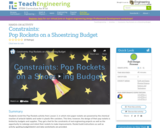
In this activity, students revisit the Pop Rockets activity from Lesson 3. This time, however, the design of their pop-rockets will be limited by budgets and supplies. They will get a feel for the limitations of a real engineering project as well as an opportunity to redesign and retest their rockets.

Academic libraries are undergoing evolutionary change as emerging technologies and new philosophies about how information is created, distributed, and shared have disrupted traditional operations and services. Additionally, the population that the academic library serves is increasingly distributed due to distance learning opportunities and new models of teaching and learning. This article, the first in this special issue, suggests that in today’s increasingly networked and distributed information environment, the strategic integration of open curation and collection development practices can serve as a useful means for organizing and providing structure to the diverse mass of available digital information, so that individual users of the library have access to coherent contexts for meaningful engagement with that information. Building on insights from extant research and practice, this article proposes that colleges and universities recognize a more inclusive open access environment, including the integration of resources outside of those owned or created by the institution, and a shift toward policies that consider open access research and open educational resources as part of the library’s formal curatorial workflow and collection building. At the conclusion on this article, authors Lisa Petrides and Cynthia Jimes offer a commentary on the six remaining articles that comprise this special issue on Models of Open Education in Higher Education, discussing the significant role that “open” policy and practice play in shaping teaching, learning, and scholarship in the global context of higher education.
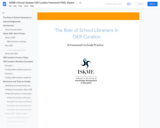
This document is an evidence-based guide that outlines the practical and policy supports needed to enable K-12 school librarians to take on leadership roles around OER, and to support OER curation efforts by librarians and all educators.
This guide is based on a study led by ISKME (iskme.org) in collaboration with Florida State University's School of Information. The study is titled “Exploring OER Curation and the Role of School Librarians". ISKME designs guides and toolkits that help educators navigate and implement new teaching and learning practices. Grounded in research, our evidence-based guides and toolkits help articulate what actually works in real education settings—and are tailored to the unique professional learning needs of our clients and their stakeholders.
The study was made possible in part by the Institute of Museum and Library Services (www.imls.gov), under grant number LG-86-17-0035-17. The findings and recommendations expressed in this document do not necessarily represent those of the Institute of Museum and Library Services.
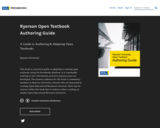
This book is a practical guide to adapting or creating open textbooks using the Pressbooks platform. It is continually evolving as new information, practices and processes are developed. The primary audience for this book is community members at Ryerson University, Ontario who are interested in creating Open Educational Resources; however, there may be content within this book that is useful to others working on similar Open Educational Resource initiatives.
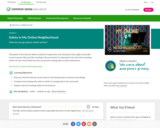
The power of the internet allows students to experience and visit places they might not be able to see in person. But, just like traveling in the real world, it's important to be safe when traveling online. On this virtual field trip, kids can practice staying safe on online adventures.
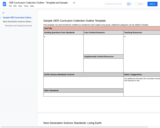
A template for developing openly licensed educational resources from Grossmont Union High School District.
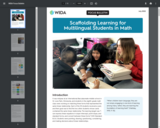
It was midyear at an International Baccalaureate middle school in
St. Louis Park, Minnesota, and students in the eighth-grade math
class were working on matching three forms that represented the
same linear relationship. Each of the 33 students received a card,
and their goal was to find the two other students whose cards
contained the same linear relationship. The learning target was “I
can express linear equations in slope-intercept, point-slope, and
standard forms, and convert between these forms” (MN Standard
8.2.4). Students were pointing, drawing, questioning, considering,
and making decisions about linear relationships
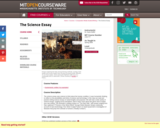
The science essay uses science to think about the human condition; it uses humanistic thinking to reflect on the possibilities and limits of science and technology. In this class we read and practice writing science essays of varied lengths and purposes. We will read a wide variety of science essays, ranging across disciplines, both to learn more about this genre and to inspire your own writing. This semester's reading centers on The Dark Side," with essays ranging from Alan Lightman's "Prisoner of the Wired World" through Robin Marantz Henig's cautionary account of nano-technology ("Our Silver-Coated Future") to David Quammen's investigation of diseases that jump from animals to humans ("Deadly Contact")."